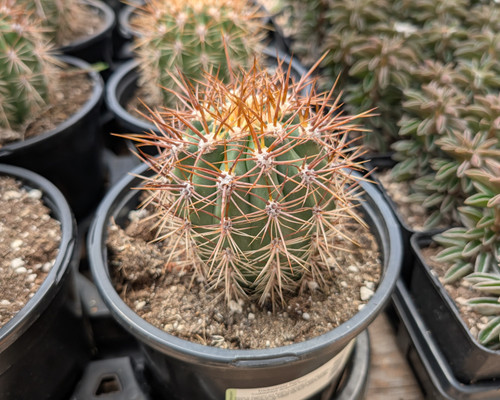Pot Size: 1 gal
Accepted Scientific Name:
Tricholobivia 'Crimsonie'
Origin and Habitat:
Tricholobivia 'Crimsonie' is a man-made hybrid cultivar, likely developed from species in the Trichocereus and Lobivia genera. The ancestral species are native to high-elevation regions of the Andes in Argentina and Bolivia, where they grow in rocky soils with good drainage, full sun exposure, and cool nighttime temperatures. These mountainous environments experience brief rainy seasons followed by long periods of drought, leading to the evolution of thick-skinned, sun-tolerant, and water-efficient cacti. 'Crimsonie' inherits its environmental hardiness from this lineage, thriving in similarly dry, sunlit settings with infrequent watering.
Description:
Tricholobivia 'Crimsonie' is a small, clumping cactus that typically grows to 3–4 inches in height and about 3 inches wide per stem. The plant produces multiple offsets, forming dense clusters over time. Stems are dark green, globular to short cylindrical, and lined with shallow ribs and small, fine spines. Its most striking feature is the profusion of deep crimson-red, funnel-shaped flowers that appear in late spring and early summer. Each bloom can reach 3–4 inches across, opening in daylight and often lasting for several days.
Cultivation:
Zone: Suitable for USDA Zones 9–11 or as a protected potted plant in colder climates.
Temperature: Thrives between 15–30°C; protect from frost and temperatures below 5°C.
Growth Rate: Moderate, with clustering growth over several seasons.
Soil: Requires a sharply-draining cactus mix with added pumice for optimal root health.
Watering: Water thoroughly only when soil is completely dry; reduce significantly in winter.
Fertilizing: Use a diluted, balanced cactus fertilizer every 2–3 weeks during spring and summer.
Light: Prefers bright light to full sun; strong light encourages flowering and compact growth.
Pests and Diseases: Generally pest-free, but watch for mealybugs and root rot in overly damp conditions.
Propagation:
Propagated by separating and replanting offsets. Allow cut surfaces to callus before placing in a dry, pumice-rich soil mix.








